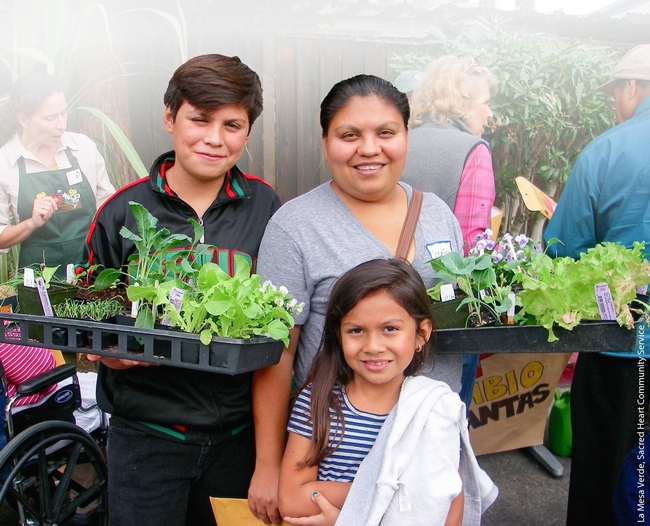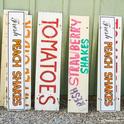
Posts Tagged: farmers market
Bay Area Bee Fair on Oct. 13: The Place to 'Bee'
It's a fair. It's a party. It's a pollinator party. It's the Bay Area Bee Fair in Berkeley. And it's the place to be on Sunday, Oct. 13 at the Berkeley Flea Market, located at Ashby BART. The second annual event, free and family friendly, is set from 10 a.m. to 3 p.m. It will feature a...

Black-tailed bumble bee, Bombus melanopygus, nectaring on nectarine blossoms. (Photo by Kathy Keatley Garvey)

A yellow-faced bumble bee, Bombus vosnesenskii, nectaring on Mexican sunflower, Tithonia. (Photo by Kathy Keatley Garvey)

A black-tailed bee, Bombus californicus, nectaring on blanket flower, Gaillardia. (Photo by Kathy Keatley Garvey)

A bumble bee, Bombus vosnesenskii, and honey bee, Apis mellifera, sharing a purple coneflower, Echinacea purpurea. (Photo by Kathy Keatley Garvey)
Lucy Diekmann, Ph.D. joins UCCE as Urban Agriculture and Food Systems Advisor for Santa Clara and San Mateo Counties

Silicon Valley's culture of innovation, diverse culinary traditions, fertile soils, and Mediterranean climate offer unique food system opportunities. In addition to large tech companies, these two counties are home to roughly 1300 farms with agricultural production valued at more than $450 million. Yet high land values make it difficult for farmers to find and keep land. The high cost of living also contributes to many families' struggle to put healthy food on the table. According to Second Harvest Food Bank, one in three children in Silicon Valley are food insecure. Many of those who are hungry are employed, but don't make enough to cover basic expenses in what has become the country's richest region as well as its most expensive.
Despite these challenges, this is an exciting time to work on food and agriculture in Silicon Valley. Santa Clara County is in the process of implementing the Santa Clara Valley Agricultural Plan to preserve agricultural lands and support a vibrant agricultural economy. The nonprofit organization SPUR is piloting a program to make California-grown produce more affordable for low-income families at grocery stores in San Jose and Gilroy. Civically engaged residents successfully advocated for Urban Agriculture Incentive Zones in the City of San Jose, creating new opportunities to put vacant land to productive use. The region's urban farms are involved in growing food for school cafeterias, developing a food entrepreneurship program, and educating students and the general public about food and agriculture, among many other activities.

Originally from Maine, I relocated to the Bay Area 15 years ago to pursue a PhD at UC Berkeley. For the past eight years, I've been working and raising my family in the South Bay. If you'd like to learn more about my work or Silicon Valley's food system, please be in touch. You can find me here: http://cesantaclara.ucanr.edu/Programs/contact/?facultyid=40005.
Start accepting credit card payments today!
70% of all purchases are made with plastic!
Did you know that cash is used at only 25% of point of sale purchases? Predictions are that cash will be used even less as more alternative payment methods become available. Debit and credit cards are used for over 70% of purchases. Customers enjoy the flexibility and ease of using plastic to pay for purchases. And research shows that consumers spend differently with credit cards than they do with cash! "Mental accounting” is the idea that people treat money differently based on a number of factors: where the money came from (salary vs. gift), the size of a transaction, and the form the money is in when a purchase is made. That last one is important – people tend to spend more money paying by card than paying with cash; i.e. when they don't actually see those dollars and cents leaving their hands. You should not use a credit card reader because it is a stealthy way to dupe your customers into purchasing more of your gorgeous veggies. But it is undeniable that accepting cash only sales severely limits the number of potential customers you may have at a farmers' market.
But what about the fees?!
All credit card processing companies do charge a service fee, usually around 2.75%. It may be a good idea to set a minimum for card purchases – $10. You can also feel comfortable passing the processing fee to customers by charging a convenience fee per swipe (consumers do this all of the time- think about the fees for pumping gas or withdrawing money from an ATM.) In my personal experience as a farmers' market vendor, customers often forget to grab their cash or hit the bank before a market and are relieved that they don't have to limit their market purchases. They enthusiastically whip out their plastic and are tickled by the user-friendly technology they get to use. Writing a signature across the screen of a smartphone is fun! Remember: you can always let people know that you prefer cash but having your credit card reader will help you build your customer base and make shopping at your market booth more convenient. It will probably also increase your sales.
How do I get started?
It is very simple to set up and use a smartphone credit card reader. You must have a smartphone that has a data plan (i.e. access to the Internet through a network.) Next step- set up an account with a smartphone credit card reading company. Square Up is the most used card reader available currently, though Intuit and Paypal both have similar products. I recommend Square. It is free, simple, used at many retail locations and customers are familiar with it. Once you have an account set up, you will receive a free credit card reader in the mail.It plugs into the headphone jack of your phone. You will also need to download the free app that accompanies the card reader. If you are feeling intimidated, ask a fellow market vendor for a quick tutorial.
Great sales tracking!
Once you have an account with Square, you can customize your account to track your sales. You can create “items” with specific prices or leave prices blank to fill in at check-out (in the case of items that you sell by weight.) A few quick taps of the finger and instead of a $30 payment without any details, you can record transaction details: 1 bouquet, 3 baskets of berries, and 2 pounds of tomatoes.
Another great tracking and management tool is the ability to set up employee profiles. Your employees can access your square account using a password that you assign. You are able to specify what each employee is able to do; ie accept payments, access sales records, etc.
A few tips
- You will need to update your card reader every year or so to keep up with the changing technology and improvements that Square makes. This is free to do and you will receive a reminder email. You can have as many card readers as you like- always good to have a back-up on hand.
- Square will save the personal information a customer enters to receive a receipt (either as a text message or email.) You can skip the receipt- I remind people that they will see the charge on their credit card or bank statement.
- The money you accept through Square is deposited to your specified bank account the next business day. For weekend farmers markets, this means you won't see the money until Monday. Don't forget to include these sales in your farmers' market accounting.
- Be sure to make a big sign for the farmers' market letting customers know that you accept plastic! Square will provide you with a small window decal, but you need a sign that catches the eye from across the market!
Using this technology is simple and many of you already possess the tools needed (i.e. a smartphone) to offer this simple service to your customers. Get started today!
References:
https://www.javelinstrategy.com/brochure/251
http://elearning2.uniroma1.it/pluginfile.php/101759/mod_resource/content/1/Thaler1999.pdf
Selling at CA Certified Farmers Markets: First Steps for Urban Farmers
It's National Farmers Market Week! And here in California, we're celebrating and enjoying our 764 farmers markets-more than any other state. Since many of these markets are in cities, they are an option that urban farmers often consider when deciding how best to market their products. Knowing how to get started, though, can be a challenge.
First, farmers should do some research, including visiting local markets to see the displays and gather ideas about what they might sell. It's important to contact market managers to find out if they have space available, what it costs, and talk about what products they are looking for. It's not always easy to get a spot at a farmers market, because the manager is trying to ensure the right mix of farms and products.
The manager also needs farmers who have a consistent harvest and enough volume to sell every week, and this can be challenging for urban farmers, since they are often beginning farmers and typically have very limited growing space. Even so, some market managers are happy to give urban farmers a try, and some even actively recruit them. For example, the staff of the Altadena Farmers Market in Los Angeles County has sought out and encouraged local backyard farmers to participate in their market. For more ideas on how to get started selling at farmers markets, check out the New Farmer's Guide: Cultivating Success at Farmers Markets.
Another mandatory step is for the farmer to contact their County Agricultural Commissioner's Office. In order to sell at a California Certified Farmers Market, growers must have a Certified Producer's Certificate (CPC). This certification process is part of the California Department of Food and Agriculture's Certified Farmers Market Program. An inspector will make an appointment to visit the growing area to find out what and how much the farmer is growing, and how much they project they will have available for sale. There is a small annual fee for certification. After the inspection, and paying the fee, the farmer receives a certificate to display when selling at a market. Growers can only sell what has been grown on the farm, and specifically, what is on the certificate. New crops can be added by amending the certificate. Some counties use an on-line application for the Certified Producer's Certificate.
The Certified Producer's Certificate has one main purpose. It simply certifies that a farmer is in fact growing what he or she is selling at the farmers market. At a California Certified Farmers Market, the consumer is assured that everything has been grown on the farm and has been brought to the market by the farmer, their immediate family members, or their employees. The inspection and certification process helps to ensure the integrity of this system. The CPC will not be the only requirement to sell at a farmers market. There may be other local requirements that farmers will learn about through working with the Agricultural Commissioner's staff and the farmers market manager.
Selling at farmers markets can be great for some urban farmers, but doesn't work for every situation. Drawbacks include the commitment of time each week to prepare for, travel to, and staff the booth, and challenges competing with the volume, prices and diversity of products offered by larger growers. Urban farmers have to work hard to build their customer base and find products that will appeal to the market's customers.
Farmers markets are one form of direct marketing, or selling straight from the farmer to the consumer. See our UC ANR Urban Agriculture Marketing page to learn more about marketing strategies.
The Farmers' Market Load List- Try It, You'll Like It!

Winter, my friends, is upon us. Does it always come so quickly? Though my mind spins with the ‘what ifs?’ of this closing season, I love the optimism and potential that December and January seem to always bring. With more hours of darkness in the evening, not only am I getting more sleep, I am also finding more time to dream of my “next year” farm. Oh, the “next year” farm, that beautiful beacon of financial stability and production perfection. There is not a weed in the field, the market tables are piled high with a huge selection of quality products, the animals are behind their fences, I am rested and look beautiful, and the bank account is busting at the seams. I always say (or heard said once and now repeat often), “To be a farmer you must be an optimist.” We learn from our mistakes and build upon failure, year after year after hopeful year.
How, exactly, do you learn from your mistakes? The qualitative data often seems undeniable. I remember not selling those bunches of X at market. I remember how long it took to harvest and process Y. But what of the real numbers? Perhaps the crop that in my mind seems a waste of time is actually making money due to low production costs and high sticker price. Maybe my market stand-by, the crop I always sell out of, is actually losing money because of the cost of labor at harvest. As farm business owners, we need to capture this data in order to make truly informed decisions about what we should produce. You, of course, have to grow what you love, but you also need to grow what makes you money if you want to continue farming as a profession. For those of us that sell at Farmers’ Markets, the market load list is an important tool that we should all be taking advantage of.
A load list is a way to document which crops you bring to market, the quantity you bring, the unit you sell each crop by (bunches, pounds), the price per unit, and the amount leftover at the end of market. Most farmers’ markets require you to fill out a load list for their own records though they do not take price into account. A well-kept load list will help you to figure out which crops are making money and which may be losing money. It will also help you understand sales trends (beginning vs. the end of the month; seasonal fluctuations) and help you understand the most efficient quantity of product to bring to market (not too much, not too little, but just right.)
It can be a challenge to implement a load list. I suggest thinking about a system that will work for you and your farm. Is no one filling out the harvest notes making it tough to know what quantity of which crop is loaded in the market truck? Maybe a label on each box with quantity is all you need. Then, whoever sells at the farmers’ market can quickly fill-in a load list. Is the load list kept in a tucked away location in the farmers’ market supplies and always forgotten? Try keeping it in the cash box. There is no reason to re-invent the wheel- ask for two copies of the load list required by your market and take one home. And yes, if you are on top of your game, you will enter these sales numbers into your spreadsheets, etc., when you get home and count your cash, but don’t worry if you would prefer to file them away until later to look at. If you have done the latter, now is the time to pull them out and determine which crops are making and losing money. With smart decision making based on actual sales data, your “next year” dream farm might actually come true!
Here is a sample load list spreadsheet created by the USDA:
http://www.flaginc.org/wp-content/uploads/2013/03/RT_market_load_list.pdf

UCA 118


